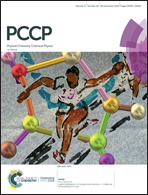Predicting the affinity of halogenated reversible covalent inhibitors through relative binding free energy†
Abstract
Nitrile reversible covalent inhibitors of human cathepsin L (hCatL) bind covalently to the side chain of the catalytic Cys25 residue in the S1 pocket to form thioimidates. Predicting the binding of reversible covalent inhibitors is essential for their practical application in drug design. In this report, five nitrile-based inhibitors coded Neq0570, Neq0710, Neq0802, Neq0803 and Neq0804 had their hCatL inhibition constants, Ki, determined. These analogs of the prototypical Neq0570 are halogenated reversible covalent inhibitors of hCatL, which bear a halogen atom in the meta position of the P3 benzyl ring that can form a halogen bond with the Gly61 of the hCatL. To describe halogen bonding interaction in an inhibitor-hCatL complex, we applied an extra point (EP) of charge to represent the anisotropic distribution of charge on the iodine, bromine and chlorine atoms. Besides, we have used alchemical free energy calculations for evaluating the overall relative binding free energies of these inhibitors using a two-state binding model: noncovalent and covalent bond states. Our results show that free energy perturbation (FEP) can predict the hCatL binding affinities of halogenated reversible covalent inhibitors in close agreement with experiments.

- This article is part of the themed collection: Celebrating Latin American Talent in Chemistry


 Please wait while we load your content...
Please wait while we load your content...